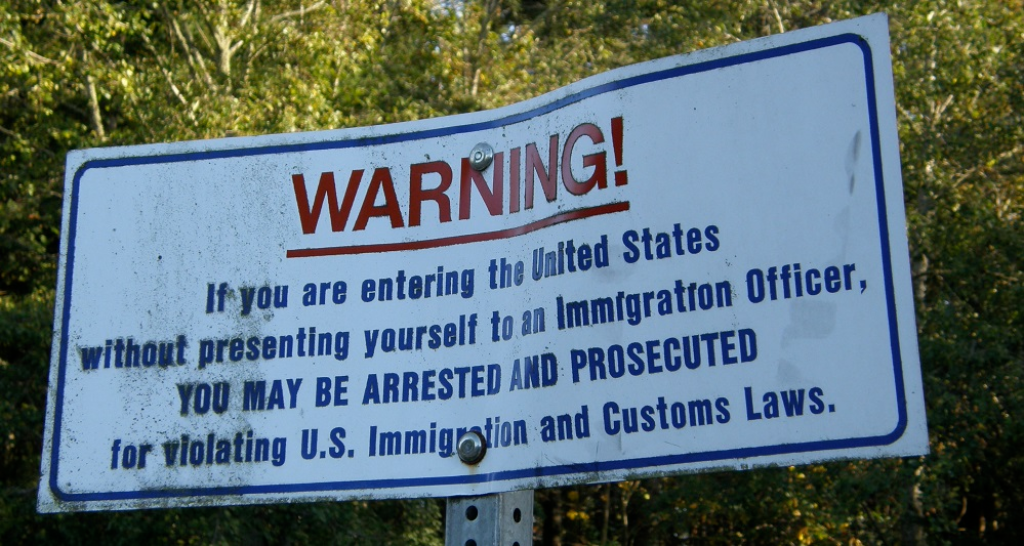Troops Sent To Guard Border Aren’t Guarding Border
Two months ago, the President called on states to send National Guard troops to the border. As expected, they're not guarding the border.

Two months ago, to much fanfare, President Trump called on the nation’s Governors, and specifically those in states close to the border with Mexico, to send National Guard troops to the border to provide security until his much-vaunted border wall could be built. As part of that announcement, Trump said he envisioned anywhere from 2,000 to 4,000 troops being sent to the border to supplement and aide immigration authorities, although the exact nature of the tasks they would perform was never made clear. While that suggestion largely fell flat even in states with Republican borders such as Texas, New Mexico, and Arizona, ultimately each state, as well as California, did send small contingents to the border region. In the end, though, between the three states there were roughly a total of 600 members the respective Nation Guards sent to the border to do, well, that still isn’t entirely clear:
In April, President Donald Trump announced he was ordering National Guard troops to the U.S. border with Mexico.
“We’re going to do some things militarily,” Trump said. “Until we can have a wall and proper security, we’re going to be guarding our border with the military.”
Here, in this dilapidated former mining town on the Mexican border, that vague directive has been translated — at least officially — to orders to help quell the smuggling operations in Agua Prieta across the fortified fence and in what is still regarded as one of America’s most corrupt locales.
They have been carrying out a variety of tasks assisting the U.S. Border Patrol in the months since their initial deployment, but all with one thing in common: They’re as far away from the border as possible. In reality, the hundreds of troops deployed in southern Arizona are keeping up the rear, so to speak; in one assignment, soldiers are actually feeding and shoveling out manure from the stalls of the Border Patrol’s horses.
Back in April, Trump hailed the deployment as a “big step,” claiming, “We really haven’t done that before, or certainly not very much before.”
But that isn’t accurate, either: Both George W. Bush and Barack Obama sent the guard to the border under similar circumstances; Bush in far larger numbers than Trump — some 6,000 compared with up to 4,000 now, and Obama to the tune of 1,200.
In Arizona, at least, the troops are being kept at an even safer distance than during previous deployments, veterans of past missions say, and assigned supporting roles that can free up Border Patrol agents for field work.
“That is the biggest difference from last time, when they sent soldiers to a hill and said, ‘Hey, look towards the border,'” Capt. Macario Mora of the Arizona National Guard explained to me on a recent visit to the Border Patrol’s Douglas Station, which is responsible for 40 miles of the mountainous border and nearly 1,500 square miles that includes Douglas — population about 17,000 — and its urban terrain of ramshackle homes, warehouses and junkyards.
“There is a false narrative that we are doing ride-alongs,” Mora said. Indeed, the troops are not permitted to take part in patrols or to participate in any operations to detain the men, women and children being trafficked by criminal organizations across the border or trying to slip undetected into Douglas.
None of the troops are even armed — “and there is no anticipation that will change,” Mora told me.
Some are helping wherever they can, such as those assigned to tend to the Border Patrol’s horses stabled in the area for mounted patrols (everyone’s favorite is Snuggles the Mustang).
Other soldiers, like Sgt. Jonathan Sanchez, 35, a cook, are performing maintenance on the Border Patrol’s heavily used vehicles.
“We fix flats,” he explained on a steamy afternoon after completing his shift in the motor pool a few miles north of town.
(…)
Supervisory Agent Juan Curbelo, a 22-year veteran of the Border Patrol, recounted in the Douglas Station how criminal organizations on the other side of the border have grown more sophisticated and more violent as the U.S. has deployed additional personnel and new technology over the years to make illegal cross-border traffic more difficult.
“They scout us quite a bit from the south side,” he reported.
He was here during the previous National Guard deployments and said that during each iteration the Border Patrol has been more innovative in finding useful things for the troops to do that keep them from interacting with people crossing the border illegally.
The reality, multiple officials related, is that the part-time soldiers are not well-suited for what is largely a law enforcement mission — and they worry that inexperienced weekend warriors might, for instance, mistakenly kill civilians or create an international incident.
“It definitely helps mitigate the risk of the National Guard running into conflict,” Mora explained of what he called the “much safer environment” they are in, miles away from the actual border.
It’s a lesson learned from those previous National Guard deployments.
In 2006, Bush sent 6,000 National Guard troops to the border — the first time military forces were expressly sent to help stanch illegal immigration, as opposed to the illegal drug trade. Then in 2010, Obama, under pressure from lawmakers from border states following the murder of an Arizona rancher, reluctantly dispatched some 1,200 troops to combat smugglers who had become increasingly sophisticated and violent.
Trump’s order called for as many as 4,000 troops from various states to help police the border stretching from California to Texas.
But still casting a shadow over the deployments is the 1997 incident in which a Marine Corps Patrol in Texas killed a local sheepherder while on border duty.”
The fact that these National Guard troops are essentially doing busy work isn’t entirely surprising primarily because Federal law limits exactly what those troops can do. Pursuant to the Posse Comitatus Act, which was first signed into law by President Rutherford B. Hayes in 1878, there are strict limits on what members of the military can do inside the borders of the United States. First of all, the act makes clear that military personnel cannot enforce Federal or state laws or do most of the other things that generally fall within the authority of police and other civilian law enforcement agencies, including the Border Patrol. They are also forbidden from detaining or searching people or doing any of the other things that a Border Patrol agents might be expected to do when interacting with someone who is a potential illegal border crosser. The law also contains other limitations on what the military can do inside the borders of the United States, but these are limitations most relevant to the current mission that the Guard is being conducted at the border.
Additionally, a Congressional Research Service report [PDF] from 2013 outlines the limitations that the act places on the use of military forces in this context:
The primary restriction on military participation in civilian law enforcement activities is the Posse Comitatus Act (PCA).21 The PCA prohibits the use of the Army and Air Force to execute the domestic laws of the United States except where expressly authorized by the Constitution or Congress. The PCA has been further applied to the Navy and Marine Corps by legislative and administrative supplements. For example, 10 U.S.C. Section 375 directs the Secretary of Defense to promulgate regulations forbidding the direct participation “by a member of the Army, Navy, Air Force, or Marines in a search, seizure, arrest, or other similar activity” during support activities to civilian law enforcement agencies. DOD issued Directive 5525.5, which outlines its policies and procedures for supporting federal, state, and local LEAs. DOD Directive 5525.5 prohibits the following forms of direct assistance: (1) interdiction of a vehicle, vessel, aircraft, or other similar activity; (2) a search or seizure; (3) an arrest, apprehension, stop and frisk, or similar activity; and (4) use of military personnel in the pursuit of individuals, or as undercover agents, informants, investigators, or interrogators. It is generally accepted that the PCA does not apply to the actions of the National Guard when not in federal service.22 As a matter of policy, however National Guard regulations stipulate that its personnel are not, except for exigent circumstances or as otherwise authorized, to participate directly in the arrest or search of suspects or the general public.
It is because of this law, and because of other policy restrictions placed on the National Guard, that it should comes as no surprise that the Guard members That being said, the National Guard has been used in the past to act in a support role along with local law enforcement and Federal border authorities. In it’s largest scope, this happened in 2006 when President George W. Bush sent roughly 6,000 troops to the border to assist with operations and in 2010 when President Obama sent 1,200 troops on a similar mission. Additionally, in the past Governors of border states, principally Texas, have done the same thing when there have been large inflows of immigrants and the Federal authorities at the border have been overwhelmed. On all of those occasions, the operations carried out by the National Guard were limited both in scope and in time and were typically used only in geographically limited basis on an as-needed basis. Which is exactly what we’re seeing now. Eventually, though, those troops were withdrawn when it was perceived that they were no longer needed. Given the fact that the troops that are there have been doing ridiculously menial tasks like shoveling horse manure, it would seem clear that we’ve reached that point now.
Back when the President first put this whole idea Cato’s Alex Nowrasteh called the proposal “unnecessary and dangerous”:
President Trump has ordered troops to the border to help the current number of 19,437 Border Patrol agents apprehend the roughly 1,000 Central American asylum seekers who are slowly making their way north (but probably won’t make it all the way to the border). There are currently about 19 Border Patrol agents for each Central American asylum-seeker in this caravan. In 2017, Border Patrol apprehended about 360,000 illegal immigrants or about 18 per Border Patrol agents over the entire year, which works out to one apprehension per Border Patrol agents every 20 days. By that measure, Border Patrol agents in 1954 individually apprehended an average of 53 times as many illegal immigrants as Border Patrol agents did in 2017. If the current caravan makes it to the United States border, it would add about a single day’s worth of apprehensions. Border Patrol should be able to handle this comparatively small number of asylum seekers without military aid as they have done so before many times.
It is also unclear what the troops will actually accomplish on the border. Since the members of the caravan intend to surrender to Border Patrol or Customs Officers and ask for asylum, the troops serve no purpose. They will not deter asylum seekers. Border Patrol agents are not overwhelmed by entries even though they constantly plead poverty in an effort to capture more taxpayer resources. The most likely explanation for the proposed deployment is politics, just like the previous deployments.
(…)
[T]he proposed deployment of American troops to the border without a clear mission at a time of low and falling illegal immigrant entries is an unnecessary waste of time and resources that could put Americans in harm’s way for no gain.
And that, of course, is exactly what’s happening.




Not only had Trump never heard of Posse Comitatus before he had uttered his nonsense words, I’m guessing nobody’s bothered to inform him to this day.